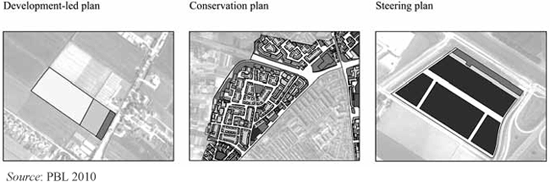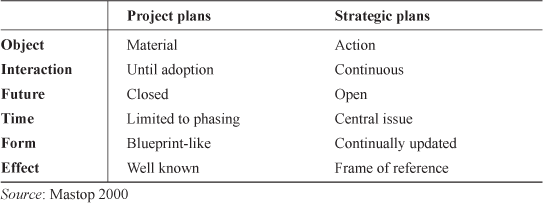The Fraught Relationship between Planning and Regulation: Land-use Plans and the Conflicts in Dealing with Uncertainty

Chapter 11
The Fraught Relationship between Planning and Regulation: Land-use Plans and the Conflicts in Dealing with Uncertainty
Planning involves institutional design. Regulations, which can be defined as legal rules that are made to structure behaviour, are important types of institutions that can be deployed for achieving aims with regard to spatial development. Planning and regulation often need each other and often go together well. Regulations are one type of resource that are employed to plan future land uses, next to for instance financial and communicative resources. And vice versa, plans such as land-use or zoning plans are often, but not always and necessarily (Neuman 1998), used to regulate land.
However, regulation is not only instrumental to planning; it can also be at odds with it. This chapter discusses the tension between both on the basis of the literature on planning and uncertainty (for example Friend and Jessop 1969; Faludi 1987; Mastop 2000) and planning and institutions (for example Bolan 1996; Gualini 2001; Alexander 2005). On the basis of this exploration, I conclude that especially strategically used (legally binding) land-use plans test the compatibility of planning and regulation.
To explore the issue further, empirical data are brought to bear on the use of land-use plans in the Netherlands. Notwithstanding the aims of the planning act from 2008, Dutch land-use plans do not plan, guide or steer spatial development, they record it and prohibit (as much as possible) deviations from these recordings. More open-ended, strategic land-use plans are impaired by rules that are aimed to fix things and minimize risks. Many of these rules originate from the field of environmental law, but also from planning law itself.
This chapter claims that there is an inherent tension between planning and regulation. Planning aims to look ahead, where regulation aims to manage what is already there. Regulation therefore involves eliminating future options and uncertainty. Planning – at least these forms that have abandoned traditional blueprint planning – tries to reduce uncertainty but also leaves, and needs to leave, room for unforeseen developments. For today’s land-use plans, there are many factors, such as vested interests, environmental law and the desire to create ‘certainty’, which favour regulation over (strategic) planning.
Planning and Uncertainty
Planning is multifaceted and multi-interpretable. It has therefore been defined in a multitude of ways. Alexander (1992) provides an interesting overview of different perspectives on what planning is and formulates his own definition based on that review. He sees planning as:
the deliberate social or organizational activity of developing an optimal strategy (a plan – EB) of future action to achieve a desired set of goals, for solving novel problems in complex contexts, and attended by the power and intention to commit resources and to act as necessary to implement the chosen strategy. (Chapter 4)
Alexander takes issue with popular views that treat planning as a ‘basic human activity’, such as planning to go the supermarket. Although individuals do indeed plan their own daily activities, in the case of urban or spatial planning we are concerned with planning activities that seek to affect the actions of groups, organizations and government. In addition, Alexander also criticizes views, such as from John Friedmann (for example 1993), in which planning and action are fused. In line with Friedmann (1993) and Wildavsky (1973), Alexander argues that planning is not just about making plans, but also about envisioning actions that are needed to implement them. Hence, planning and action are closely related but not synonymous; the former is future-oriented while the latter is present-oriented.
The fact that planning is future-oriented implies a great role for uncertainty. Friend and Jessop (1969: 88–89) distinguish between three types of uncertainty: uncertainty with regard to the physical, social and economic environment within which decisions are made, uncertainty as to future intentions in related fields of decision-making and, finally, uncertainty as to (the development of) value judgements. The uncertainty with regard to value judgements relates to the plurality and diversity of society; in this respect, some even speak of the ‘unknown society’ (Van Gunsteren 1998).
The level of uncertainty varies between different types of plans. In planning theory, a distinction has been made between strategic plans and operational or project plans, which each have their own time frames and each serve their own purposes (for example Faludi and Van der Valk 1994; Mastop 2000). Strategic plans are plans that keep the future open and account for uncertainty, while project plans are blueprint-like and have a closed view of the future (see Table 11.1). Where project plans are aimed directly at the material object, strategic plans do that more indirectly via influencing the actions of subjects. In addition, strategic plans are more a step in a cyclical or an iterative (interactive) process than the end product, such as the project plan. Healey et al. show the distinct character of strategic planning by defining it as a social process through which a range of people in diverse institutional relations and positions come together to design plan-making processes and develop contents and strategies for the management of spatial change. This process generates not merely formal outputs in terms of policy and project proposals, but a decision framework that may influence relevant parties in their future investments and regulatory activities. (1997: 5)
Table 11.1 Project plans and strategic plans

Given these features, one can actually question if project plans, in their pure form as defined here, exist on a large scale. Most planning problems are too complex, and the effects of decisions too uncertain, to treat plans as blueprints with a closed view on the future. Some form of strategic action is often required. Dealing with limited knowledge and uncertainty also implies flexibility, we have moved beyond the times of blueprint or end-state plans (Taylor 1998). Flexibility also means leaving options open instead of prescribing directions in detail.
Planning as Institutional Design
Much of what planning does is institutional design (Bolan 1996; Alexander 2005). Some even go as far as to say that planning is institutional design (Innes 1995). Institutions help guiding future developments and future interaction. Adopting a land-use or zoning plan and drawing a spatial vision for a particular territory are indeed acts of institutional design. But also the active development of locations by developers or local authorities can be seen as maintaining or deviating from institutions with regard to land development, and hence as (re)designing institutions.
Regulations can be seen as institutions in as far as they have become socially accepted and embedded. Earlier, it has been argued that the extent to which rules are institutionalized is indicated by the actual use of them (Buitelaar, Galle and Sorel 2011). This implies that not all regulations within planning law are institutionalized, or at least not at every level. For instance, the Dutch planning act contains the instrument of the ‘conservation ordinance’ (beheersverordening). Although its introduction in the act is the result of an institutionalization process at the central political and administrative level, locally it has not become institutionalized – for various reasons – since it is seldom used.
Institutionalized regulations are key instruments for implementing planning policies. Zoning rules, subdivision rules, rules for septic systems, minimum lot-size requirements, density rules, infrastructure requirements and so on are often seen as essential means to shape urban development in a publicly desired direction. However, at the same time, they have the potential to inhibit planning. This is related to the sometimes contradictory aims of planning and regulation. Where planning often seeks to make things happen, regulations are more likely to prevent things from happening.
This has to do with the raison d’être of regulation. There is a clear link between the emergence of regulations – in particular public law rules – on the one hand and the growing complexity of modern society, and the risks associated to that, on the other. The emergence of the ‘risk society’ (Beck 1989) and the ‘regulatory state’ (Majone 1994) seem to go hand in hand.
The growth of administrative regulation in Europe owes much to (these) newly articulated perceptions of a mismatch between existing institutional capacities and the growing complexity of policy problems: policing financial markets in an increasingly interdependent world economy; controlling the risks of new products and new technologies; protecting the health and economic interests of consumers without impeding the free flow of goods, services and people across national boundaries; reducing environmental pollution. (Majone 1994: 85 – brackets by the author)
Regulations take the place of more direct forms of government intervention such as central planning and public ownership. They have the ability to create some certainty in highly complex and individualized societies.
Not only do rules have the ability to reduce risks for society, they can do the same for policy-makers and politicians. Weaver (1986) argues that policy-makers are inherently blame avoiding, rather than credit claiming because ‘voters are more sensitive to what has been done to them than to what has been done for them’ (Weaver 1986: 373). This inclination has become stronger with an increase of mediatized politics (Hajer 2009). Nowadays, political mistakes are illuminated, inflated and disseminated under large numbers of people in a short period of time. The chances of personal mistakes are reduced through regulations since these standardize, eliminate or overtake discretionary policy decisions. This is in line with Weber’s bureaucratic ideal (Weber 1922).